
Table of Contents
RV batteries last from 3 to 15 years, depending on the type and level of maintenance. Lead-acid batteries, commonly found in recreational vehicles (RVs), function effectively for 3 to 5 years with proper upkeep, including electrolyte level checks and avoiding deep discharges. AGM batteries offer greater durability, lasting between 4 and 7 years while requiring less maintenance. Lithium-ion batteries provide the longest lifespan, from 8 to 15 years, superior performance, and minimal upkeep. Routine care, such as cleaning terminals and maintaining optimal charging levels, is vital in extending battery life. Storage at appropriate temperatures and maintaining a partial charge during periods of non-use contribute to longevity. Camper battery performance benefits from regular inspections and timely recharging. Lithium-ion batteries are the best option for frequent travelers due to their efficiency and extended lifespan.
RV battery lifespan and performance face significant challenges from temperature extremes, overcharging, and improper storage. Maintenance practices, including terminal cleaning and voltage monitoring, help prevent common issues such as corrosion, deep discharging, and difficulty holding a charge. The RV battery system manages 12V DC and 120V AC power, utilizing multiple charging sources, including solar panels and shore power. Extended warranties rarely cover batteries for RVs, as they fall under consumable items.
How Long do RV Batteries Last?
RV Battery lasts between 3 to 15 years, depending on type. Lead-acid batteries, the most common and affordable option, last 3 to 5 years with regular maintenance, such as checking electrolyte levels and avoiding deep discharges. AGM (Absorbed Glass Mat) batteries are more durable, lasting 4 to 7 years, requiring less upkeep, and are sensitive to overcharging. Lithium-ion batteries offer the most extended lifespan, ranging from 8 to 15 years, providing superior performance with minimal maintenance. Proper care, such as cleaning terminals, securing connections, avoiding deep discharges, and maintaining adequate charging levels, helps extend battery life. Storing batteries at appropriate temperatures and ensuring a partial charge when unused contributes to longevity.
An RV Battery nearing the end of its lifespan shows clear signs of deterioration. Dimming lights and reduced power output indicate that appliances are not running efficiently. A slow engine crank suggests difficulty starting the engine. Visible corrosion, leaks, or unusual odors signal internal damage. A battery struggling to hold a charge or taking longer than usual to recharge points to declining performance. Replacing the RV battery properly prevents power failures and ensures reliable operation during RV trips.
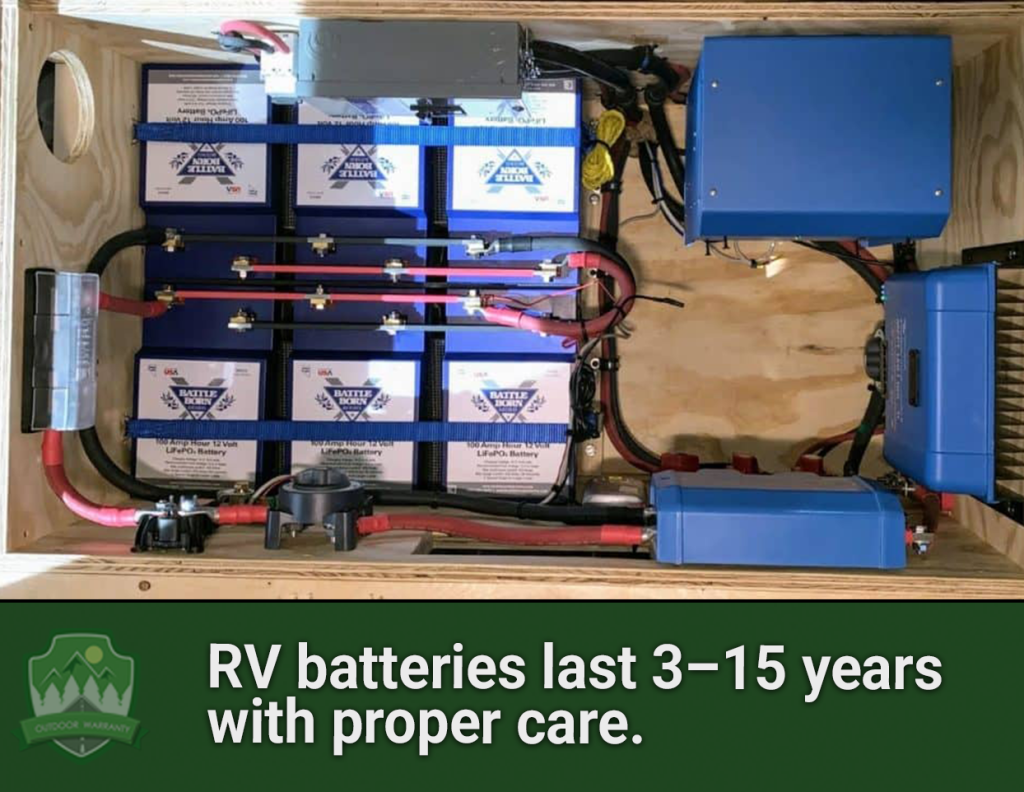
How Long does an RV Battery Last on One Charge?
An RV battery lasts between 24 hours and several days on one charge, depending on the battery type and power consumption. A standard 12V deep-cycle lead-acid battery powers essential appliances like lights and a water pump for about 24 hours. High-power appliances such as a microwave or air conditioner drain the battery within a few hours. Lithium batteries provide longer usage due to higher energy density and deeper discharge capacity. Energy-efficient practices, including limiting appliance use and utilizing propane alternatives, extend battery life up to three days.
The RV battery’s lifespan without shore power depends on capacity and energy consumption. A 100Ah deep-cycle battery supports minimal appliance use for approximately 24 hours. High energy consumption from refrigerators or entertainment systems reduces the duration. Proper charging maintains efficiency and extends longevity. A compatible charger set to the correct voltage ensures safe and effective charging. A 100Ah battery takes about two hours to reach 80% capacity with a 50A charger. Overcharging damages battery health and must be avoided.
An RV battery lasts between two and seven days when dry camping, depending on energy usage and battery type. LED lighting and propane-powered appliances reduce power demand. Solar panels recharge batteries during the day, extending their usability. Lithium batteries outperform lead-acid options by offering more usable energy and faster recharge times. Battery monitors and management systems prevent excessive discharge and help maintain long-term performance.
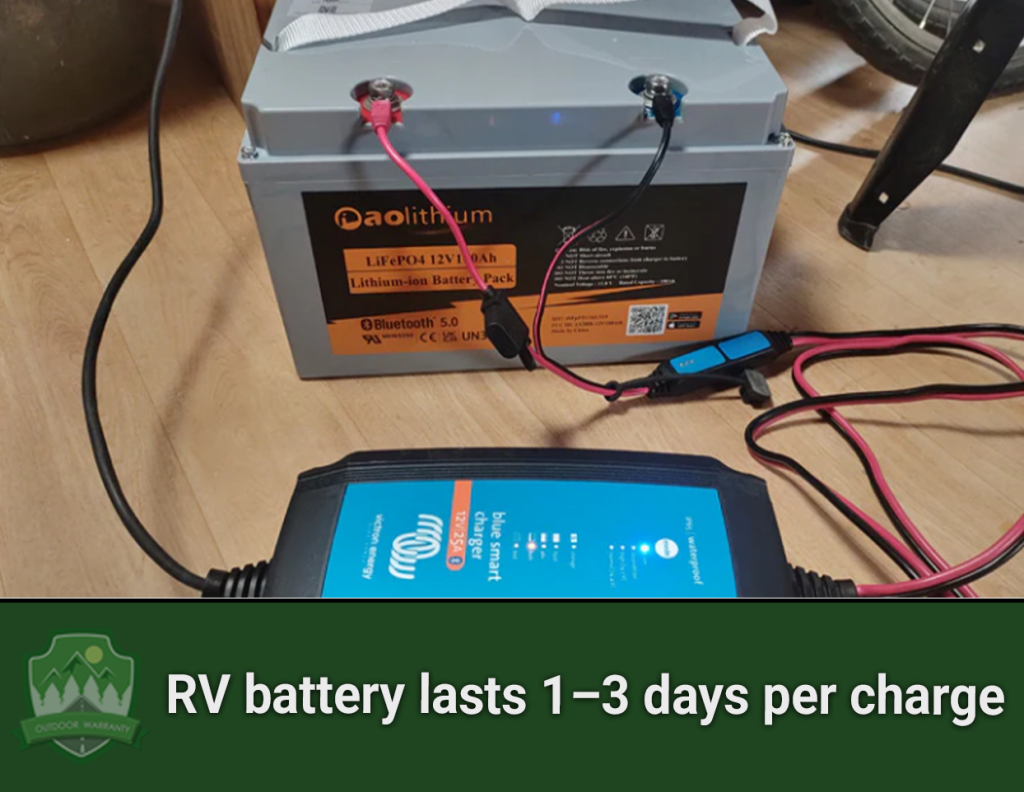
How Long do Camper Batteries Last?
Camper batteries last between 3 to 15 years, depending on the type and usage. Flooded lead-acid batteries last 3 to 4 years or 200 to 500 cycles but require regular maintenance and leak or emit gases. AGM batteries have a lifespan of 3 to 7 years or 500 to 800 cycles, offering a maintenance-free experience with better durability, though they are sensitive to deep discharges. Lithium-ion (LiFePO4) batteries provide the longest lifespan of 10 to 15 years or 2,000 to 4,000 cycles, featuring high energy efficiency and a lightweight design, but they come at a higher cost and underperform in extreme cold.
The lifespan of a Camper Trailer battery is influenced by factors such as usage patterns, maintenance, environmental conditions, and charging techniques. Frequent deep discharges shorten the Camper Trailer battery life, while proper charging methods help maintain efficiency. Extreme temperatures reduce performance, making storing and charge batteries properly essential. Flooded lead-acid batteries are best for budget-conscious users willing to perform regular upkeep, AGM batteries suit campers wanting a low-maintenance option, and lithium-ion batteries are ideal for long-term, high-efficiency needs despite the initial investment.
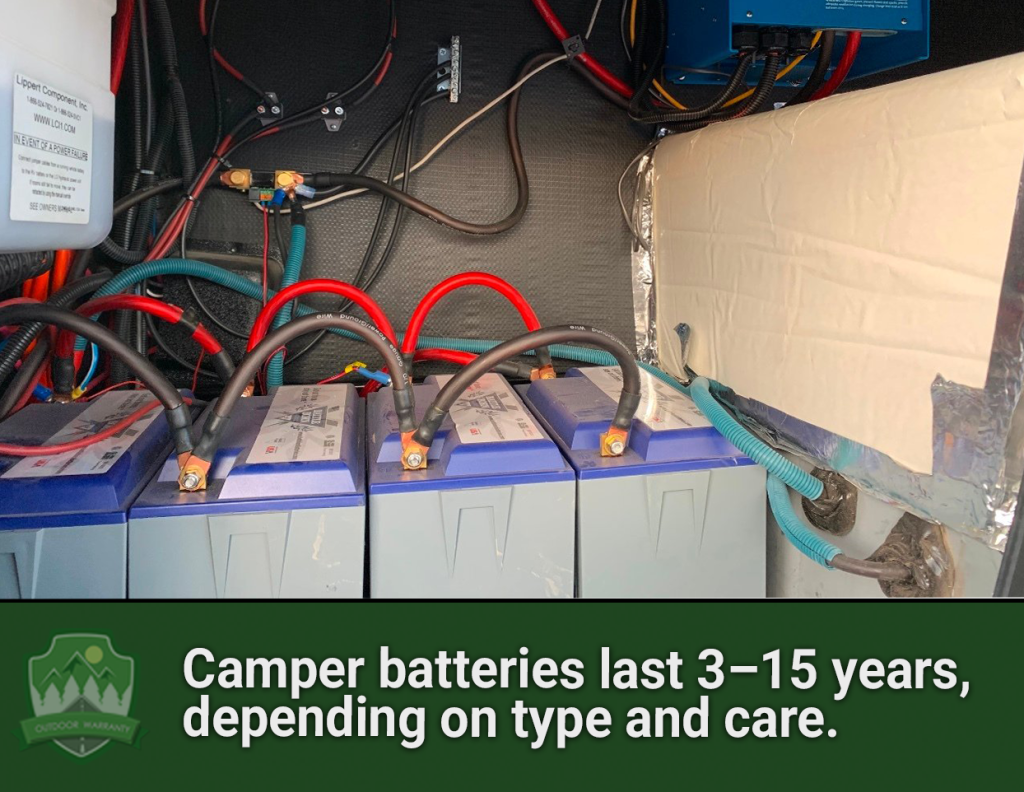
How Long do Travel Trailer Batteries Last?
Travel Trailer batteries last 2 to 10 years, depending on the type and maintenance. Flooded lead-acid batteries last 2 to 5 years but need regular maintenance, such as checking water levels. AGM (Absorbed Glass Mat) batteries last 3 to 7 years, are maintenance-free, and handle vibrations well. Gel batteries last 4 to 6 years and do not require maintenance but are sensitive to charging rates. Lithium batteries offer the most extended life cycle, exceeding 10 years, and are lightweight, efficient, and maintenance-free.
Factors impacting Travel Trailer battery life include charging practices, frequency of deep discharges, temperature conditions, and maintenance. Overcharging or undercharging shortens battery life, and extreme heat or cold affects performance. Lithium batteries provide superior efficiency and longevity for frequent Travel Trailer use with high power demands. Flooded lead-acid batteries offer an affordable solution for occasional travel with basic power needs. Proper storage and regular maintenance extend battery life, ensuring reliable trip use.

What are the Different Types of RV Batteries?
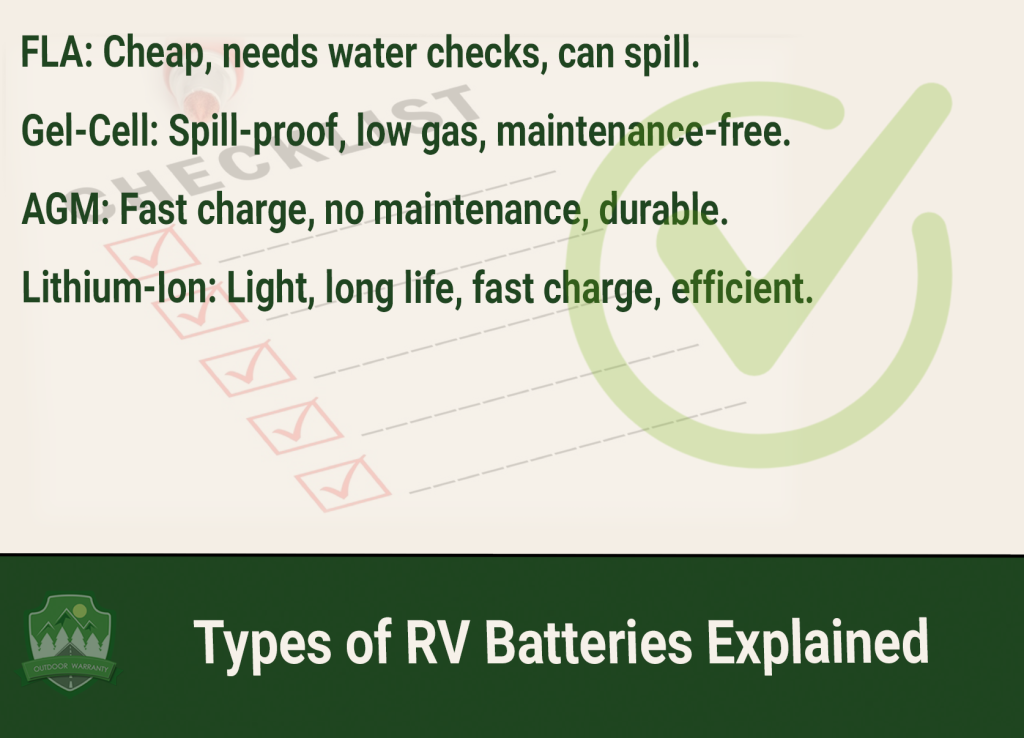
The different types of RV batteries are listed below.
- Flooded Lead-Acid Batteries (FLA): FLA batteries contain liquid sulfuric acid as the electrolyte. They are used because of their affordability. Regular maintenance is required, including checking water levels. Spills occur if they are not appropriately handled. Budget-conscious RV owners who manage upkeep benefit the most from FLA batteries.
- Gel-Cell Batteries: The electrolyte in these sealed lead-acid batteries is in gel form. They are spill-proof and mounted in different positions. Off-gassing is lower compared to FLA batteries. RVs with limited ventilation are best suited for Gel-cell batteries.
- Absorbed Glass Mat (AGM) Batteries: Fiberglass mats absorb the electrolyte in these sealed lead-acid batteries. The charging speed is faster than that of FLA batteries. Maintenance is not required, and resistance to vibrations and heat is high. Many Types of Recreational Vehicle setups, like Class B Camper Vans and Fifth-wheel Trailers, use these batteries for reliable and low-maintenance power.
- Lithium-Ion Batteries: Lithium salts serve as the electrolyte in these high-performance batteries. Charging is fast, and deep discharge capabilities extend their lifespan. Their weight is lower than other battery types, making them easy to transport. Maintenance is minimal, making them ideal for RV owners who need efficiency and off-grid reliability.
What is the Best Type of Battery for an RV?
RV water heater issues disrupt comfort during travel. Causes include faulty thermostats, sediment buildup, or electrical malfunctions. Check the thermostat setting and ensure the power source is functioning to fix the issue. Flushing the water heater to remove sediment buildup restores proper function. Prevent problems by regularly flushing the water heater and inspecting for signs of wear or corrosion. RV power problems affect water heater operation in older models. Regular maintenance, such as checking for leaks and testing the heating elements, ensures reliable hot water.
Can I Replace My RV Battery with a Lithium Battery?
Yes, you can replace your RV battery with lithium, but compatibility factors must be considered. The charger and converter must work with lithium technology to prevent improper charging. Lead-acid chargers must be replaced with a lithium-compatible model, such as the PD9260C 60Amp RV Inverter Charger. Lithium batteries are lighter and more compact, decreasing RV weight and saving space, but a larger battery box is required if the new battery has different dimensions. Voltage compatibility is essential, as lithium batteries operate at 12.8 volts, which requires adjustments to the inverter and fuse box.
Lithium batteries offer advantages over lead-acid batteries, as they last longer, have a lifespan of up to 10 years, and support deeper discharge cycles without losing capacity, allowing up to 80% usable energy. Their lightweight design improves fuel efficiency and handling. Installation requires modifications, such as ensuring the battery has an internal Battery Management System (BMS) to regulate voltage and temperature. Upgrading the inverter, charger, and wiring is necessary. Professional installation is recommended for RV owners unfamiliar with electrical systems to guarantee safe and efficient operation.
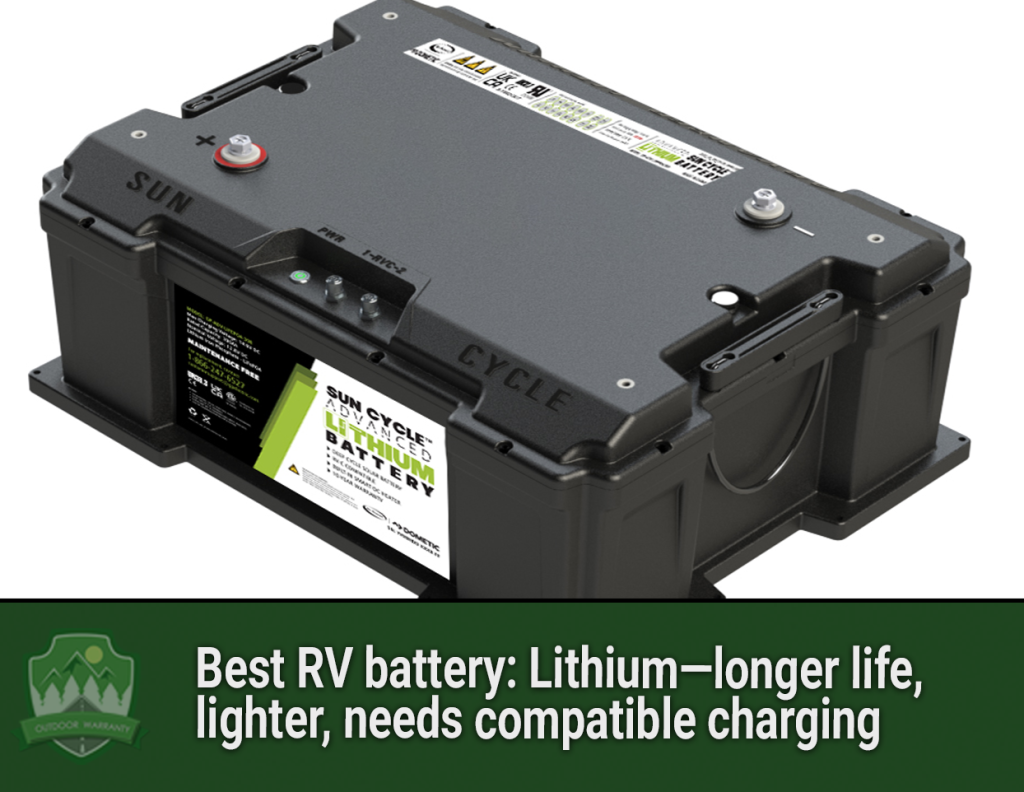
How To Maintain RV Batteries for Longer Life?
To maintain RB batteries for longer life, follow the seven steps listed below.
- Charge Batteries Properly. Using a smart charger prevents overcharging, which causes electrolyte loss in lead-acid batteries and shortens their lifespan. Keeping charge levels above 50% avoids deep discharges, which lead to sulfation, a buildup of sulfate crystals that reduces battery efficiency and longevity.
- Follow Stage Charging. Proper charging involves three key stages such as bulk charging replenishes most of the charge quickly, absorption charging slows down the process to ensure full capacity, and float charging maintains the charge without overloading the battery. These stages prevent overcharging and extend battery life.
- Clean Battery Terminals. Corrosion on battery terminals weakens electrical connections, leading to power loss. Cleaning them with a baking soda and water mixture or a commercial cleaner removes buildup, while applying petroleum jelly or terminal protector spray helps prevent future corrosion and ensures a strong connection.
- Check Fluid Levels. Electrolyte levels in flooded lead-acid batteries must be checked monthly and maintained between ¼ and ½ inch above the plates. Adding only distilled water prevents mineral buildup that damages the battery, ensuring it operates efficiently and lasts longer.
- Store Batteries Correctly. Batteries must be disconnected or switched off when not in use to prevent unnecessary discharge. Storing them in a dry, cool place away from moisture and extreme temperatures helps maintain charge levels and prevents deterioration due to environmental conditions.
- Charge During Storage. Batteries naturally self-discharge over time, so they must be fully charged before storage and recharged every 3 to 6 months. Regular charging prevents sulfation, which permanently reduces battery capacity and makes it difficult to restore proper function.
- Use a Battery Maintainer or Trickle Charger. A battery maintainer or trickle charger helps keep batteries at an optimal charge level without overcharging. These devices prevent deep discharge and sulfation, ensuring that stored or rarely used batteries remain in good working condition and are always ready for use.
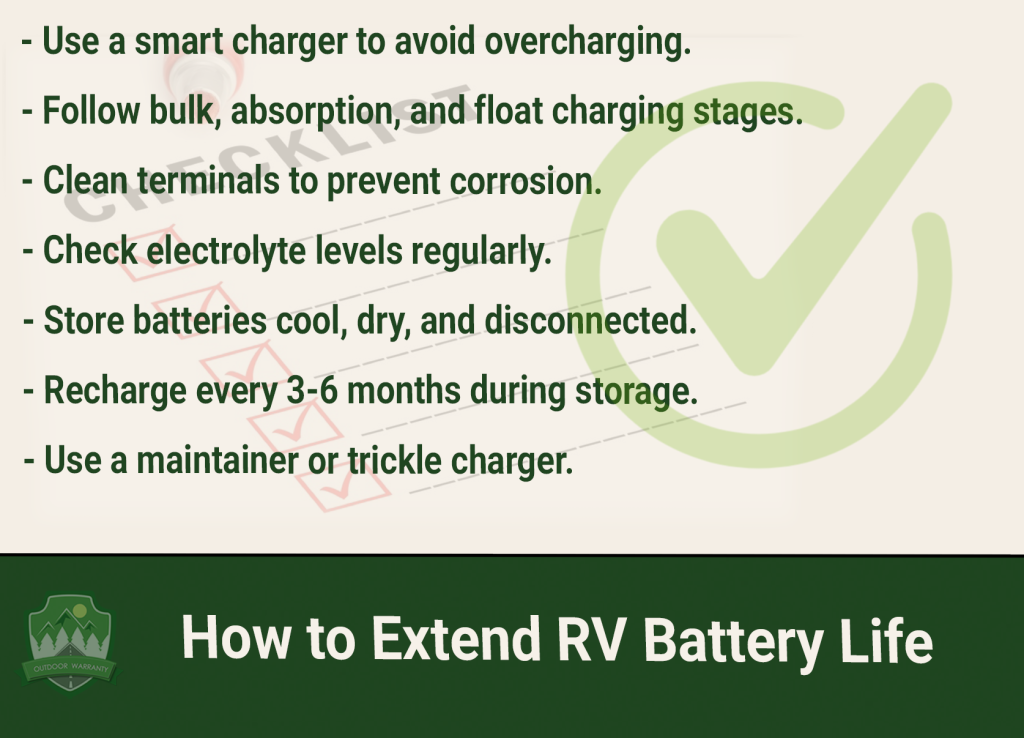
Should I Remove My RV Battery for Winter Storage?
Yes, you should remove your RV battery for winter storage to prevent damage from extreme cold. Low temperatures reduce battery efficiency and cause the electrolyte to freeze, leading to cracks or permanent failure. Extreme cold decreases battery capacity, making it less effective when reinstalled. Checking and filling water levels ensures the battery stays in good condition before removal. Charging the battery helps maintain its health during storage. A warm, dry location such as a garage or basement provides the best storage conditions. A battery maintainer keeps the charge stable and prevents degradation. RV Winterization includes disconnecting electrical systems to avoid accidental power drains. Insulating the battery box offers protection, but removal is the safest option. Proper storage extends battery life and prevents costly replacements.
How to Properly Store RV Batteries?
To properly store RV batteries, follow the six steps listed below.
- Maintain Optimal Temperature. Store batteries in a cool, dry place away from direct sunlight and heat sources to avoid internal damage. Keep the storage area above freezing temperatures since discharged batteries freeze easily.
- Charge and Recharge. Fully charge the battery before storage to prevent deep discharge. Check and recharge monthly to maintain a healthy charge level. Use a smart charger to avoid overcharging.
- Choose the Right Storage Location. Select a storage area that is cool and dry to avoid moisture-related damage. Disconnect the battery from the RV to prevent parasitic drain and store it separately.
- Monitor and Maintain. Use a battery monitor to track charge levels and battery health. Follow the manufacturer’s maintenance guidelines to ensure longevity and proper function.
- Consider Battery Type. Flooded lead-acid batteries require regular watering and are sensitive to extreme temperatures. AGM batteries need less maintenance but require careful storage. Lithium batteries must be stored between 10°C and 30°C (50°F to 86°F) with a charge level of 40% to 60% for long-term storage.
- Follow Safety Precautions. Ensure proper ventilation around stored batteries to prevent gas buildup. Keep batteries away from combustible materials, and never charge them on flammable surfaces.
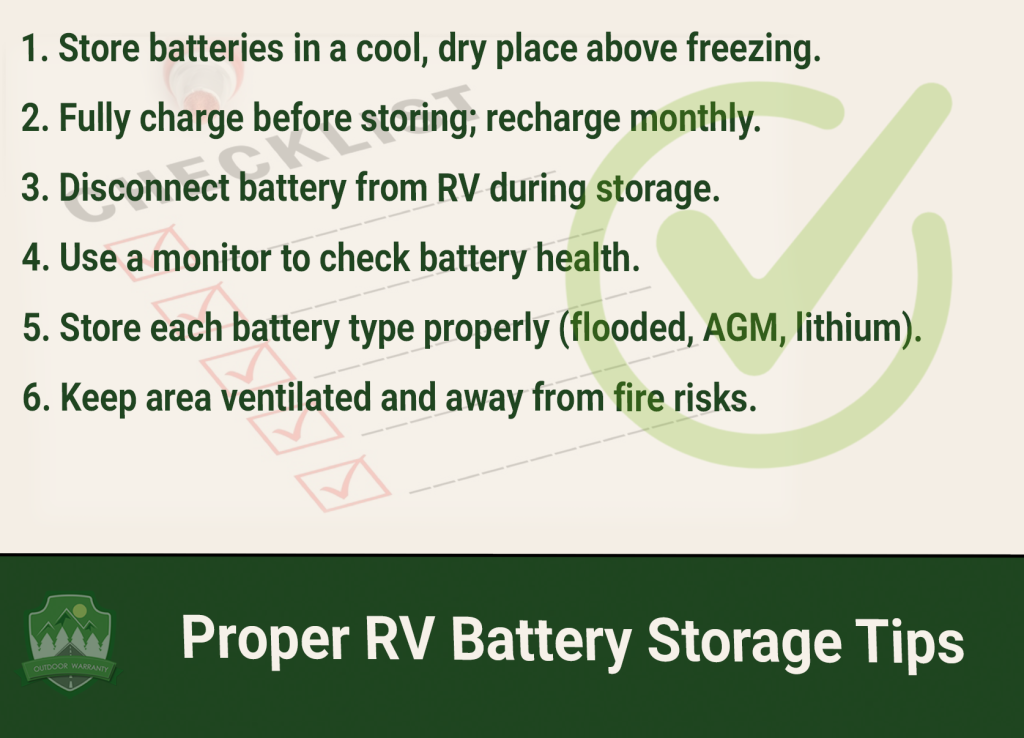
What Causes RV Batteries to Drain Quickly?
The causes of RV batteries draining quickly are listed below.
- Phantom Loads: Small devices like clocks, CO detectors, and security systems draw power even when unused. Installing a battery disconnect switch prevents unnecessary drain.
- Poor Maintenance: Neglecting lead-acid battery water levels, failing to clean terminals, and improper charge maintenance reduce efficiency and lifespan. Regular inspections and upkeep help maintain performance.
- Extreme Temperatures: Cold weather increases internal resistance, while hot temperatures accelerate fluid evaporation and degradation. Insulating batteries in cold weather and parking in shaded areas during heat minimizes damage.
- Overcharging: Faulty charging systems or prolonged connection to high-voltage sources cause electrolyte loss, reduced capacity, and possible failure. Using a regulated charger prevents overcharging.
- Undercharging: Insufficient charging time or low voltage creates a surface charge that depletes quickly, leading to premature drain. Ensuring full charge cycles improves longevity.
- Over-Draining: Discharging batteries below 50% capacity regularly leads to permanent damage and a shorter lifespan. Keeping charge levels above 50% preserves battery health.

What Size Battery Do I Need for My Travel Trailer?
The battery size you need for your travel trailer depends on total power consumption, system voltage, and the duration of off-grid use. Common battery sizes include 100Ah, 200Ah, 400Ah, and 600Ah, with selection based on energy needs. Calculating power needs requires identifying all electrical appliances, noting their wattage, and estimating daily usage in watt-hours (Wh). Dividing the total Wh by 12V converts it into amp-hours (Ah). Multiplying by the number of days without recharging determines the required battery capacity. A daily consumption of 1200 Wh with a two-day autonomy requires a 200Ah battery. Larger capacities or solar charging solutions become essential for extended off-grid stays.
A single 12V battery offers a simple setup but has a lower capacity than a dual 6V configuration. Two 6V batteries wired in series provide 12V and deliver 200-225Ah, making them ideal for longer trips. Campground stays with frequent access to shore power work with a single 12V 100Ah battery. Boondocking demands a higher capacity, at 200Ah or more, depending on appliance use and charging availability. Air conditioners and high-wattage devices require battery banks exceeding 400Ah, with multiple batteries connected in parallel.
Light usage, such as LED lighting and phone charging, function well with a 100Ah battery. Moderate consumption, including a small refrigerator and TV, benefits from a dual 6V setup with 200-225Ah capacity. Heavy power demands from large appliances or long off-grid stays require 400-600Ah or more. Solar panels or generators help sustain battery life when recharging opportunities are limited. Selecting the correct battery setup depends on specific energy needs and available charging options.

How Does an RV Battery System Work?
The RV battery system works by managing 12V DC and 120V AC power to operate different appliances. The 12V system supplies energy to essential components such as lights, fans, and water pumps. A battery bank consisting of 12V or multiple 6V batteries is connected in series to store the 12V system. A converter/charger transforms 120V AC into 12V DC when the RV connects to shore power, supplying energy to the system and recharging the batteries. The 120V system powers larger appliances like microwaves and refrigerators. An inverter converts stored 12V DC into 120V AC, allowing off-grid operation for these appliances.
Multiple charging sources keep RV batteries powered. Solar panels generate DC power, which a charge controller regulates for safe battery charging. A generator produces AC power, which a converter changes to DC for battery replenishment. A vehicle alternator sends power to the battery bank while driving, ensuring continuous charging. Shore power remains the most stable option, directly supplying electricity and charging the batteries through the converter. A complete system with solar panels, a converter/charger, an inverter, and deep-cycle batteries enables RVs to function reliably on and off the grid.
How Do RV Batteries Charge?
RV batteries are charged using shore power, solar panels, a generator, and the vehicle’s alternator. Shore power provides a stable 120V AC connection at campgrounds, with a converter transforming AC to DC for battery charging. Solar panels collect energy from the sun and utilize a charge controller to manage power flow, which is ideal for off-grid use. A generator produces AC electricity, which the RV’s converter changes into DC for charging. The alternator recharges batteries while driving, ensuring they remain charged during travel.
A converter and an inverter play key roles in power management. The converter changes AC from shore power or a generator into DC for battery charging. The inverter does the opposite, converting DC from the battery into AC to run appliances. Charging speed varies between battery types. Lithium batteries charge faster than lead-acid batteries due to increased performance and lower resistance. A 50-amp converter charges a 12V 100Ah lithium battery in about 2 hours, while lead-acid batteries take longer due to their limited charge acceptance.
Should I Disconnect My RV Battery when Not in Use?
Yes, you should disconnect your RV battery when not in use to prevent phantom loads, slow discharge, and potential battery damage. Devices like clocks, smoke detectors, and stereos tend to draw power even when turned off, slowly draining the battery. Disconnecting helps preserve the charge and extend battery life. Long-term storage requires disconnection to prevent acid stratification and sulfation in lead-acid batteries, while lithium batteries avoid unnecessary discharge and deep cycle damage. Maintenance and repairs are safer with a disconnected battery, reducing the risk of electrical shocks and short circuits. Power surges from unstable shore power harm batteries, making disconnection a protective measure for lithium types. Disabling the battery is a theft deterrent that prevents unauthorized use of the RV’s electrical system.
Can a Completely Dead Rv Battery Be Recharged?
Yes, a completely dead RV battery can be recharged, but its ability to recover depends on the type and condition of the battery. Lead-acid batteries are revived if sulfation is not severe. A slow charge or a charger with an equalization mode restores some capacity. Deep sulfation or prolonged discharge causes permanent damage. Lithium batteries, such as LiFePO4, handle deep discharges better and require a specialized charger or a boost from another battery to restart. Lead-acid battery reconditioning removes sulfation through equalization charging, though full-capacity restoration is impossible. Lithium batteries do not need reconditioning and must only be charged with smart chargers designed for their chemistry. Smart chargers adjust charging parameters based on battery type. Overcharging must be avoided to prevent damage. Deeply discharged lead-acid batteries benefit from a slow charge at a low current. Battery temperature must be monitored to avoid overheating. Physical damage or prolonged discharge requires battery replacement.
Can I Run My RV without A Battery?
Yes, you can run your RV without a battery, but with limitations. Shore power supplies AC electricity, which the RV’s converter transforms into DC power for essential systems. The setup runs lights, appliances, and electronics but lacks a battery to stabilize voltage. Fluctuations occur, potentially harming sensitive equipment. Specific systems require a steady DC power supply, including slide-outs, leveling jacks, and propane appliances. Emergency braking systems in trailers rely on battery power, making a battery essential for safety.
An RV converter alone struggles to maintain stable voltage without a battery. Power inconsistencies damage equipment and cause sudden drops in performance. Converters are designed to keep a battery charged rather than handle peak loads. Sudden power demands are not met efficiently. A battery remains necessary for off-grid camping, running DC-powered appliances, and ensuring critical systems function correctly. Constant shore power use with only AC appliances makes a battery optional. Backup power and system stability improve with a battery, providing added reliability.
Does the Extended Warranty Cover the RV Battery?
No, the Extended warranty does not cover the RV battery because it is classified as a consumable item rather than a mechanical or electrical component that requires repair due to failure. Batteries, like tires and filters, are considered maintenance items that naturally degrade over time and need periodic replacement. Standard extended warranties focus on major systems such as engines, transmissions, and electrical components, but they exclude consumables unless explicitly stated in the contract. Extended Warranty for RVs prioritizes major repairs rather than routine maintenance items. Comprehensive plans offer optional add-ons for specific electrical parts, but battery coverage is rare unless specified.
Understanding the type of warranty is crucial in determining coverage. Exclusionary warranties cover all components except the ones listed as exclusions, while inclusionary warranties only cover specified parts. Batteries are commonly excluded from exclusionary and inclusionary warranties unless specifically included in the policy. There are providers who offer additional coverage for high-end or specialized components, but RV owners must review their warranty terms carefully. RV owners seeking protection beyond standard plans must check for optional battery coverage or a separate maintenance plan for better coverage.